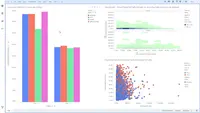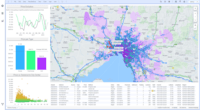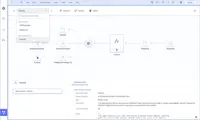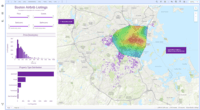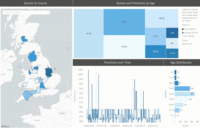Overview
What is Spotfire?
Spotfire® is a data visualization platform that utilizes predictive analytics. In addition to data viz, it includes data wrangling capabilities, predictive analytics, location analytics, and real-time streaming analytics. Spotfire® is a business unit of Cloud Software Group, formerly known…
Flexible, fast and effective data analytics tool.
Leveraging Data for Enhanced Sales Strategy using Spotfire
Spotfire capability assessment from uday to day usage
Fast and Accurate Market decision making
Insightful Manufacturing Process Interogation
Feels like a BI-Tool on Steroids
Spotfire is a powerful Visualization Tool.
Spotifire is spot-on!
Very good with visualizations
Spotfire - Make you data analysis easier
Spotfire for the Energy Industry
Very good interactive inmersive analytics for predictive maintenance
Powerful BI Platform, but Requires IT Support
Reliable and always available SaaS BI tool to handle easily massive amount of data
Awards
Products that are considered exceptional by their customers based on a variety of criteria win TrustRadius awards. Learn more about the types of TrustRadius awards to make the best purchase decision. More about TrustRadius Awards
Popular Features
- Customizable dashboards (294)9.191%
- Pre-built visualization formats (heatmaps, scatter plots etc.) (306)8.686%
- Drill-down analysis (289)8.383%
- Formatting capabilities (302)7.878%
Reviewer Pros & Cons
Video Reviews
1 video
Pricing
Spotfire for Amazon Web Services
$0.99
Spotfire Cloud - Consumer
$250/yr
Spotfire Cloud - Business Author
$650/yr
Entry-level set up fee?
- No setup fee
Offerings
- Free Trial
- Free/Freemium Version
- Premium Consulting/Integration Services
Features
BI Standard Reporting
Standard reporting means pre-built or canned reports available to users without having to create them.
- 8Pixel Perfect reports(30) Ratings
Pixel Perfect reports are highly-formatted reports with graphics and ability to preview the report before printing.
- 9.1Customizable dashboards(294) Ratings
Customizable dashboards are dashboards providing the builder some degree of control over the look and feel and display options.
- 7.9Report Formatting Templates(258) Ratings
Ad-hoc Reporting
Ad-Hoc Reports are reports built by the user to meet highly specific requirements.
- 8.3Drill-down analysis(289) Ratings
Drill down analysis is the ability to get to a further level of detail by going deeper into the hierarchy.
- 7.8Formatting capabilities(302) Ratings
Ability to format output e.g. conditional formatting, lines, headers, footers.
- 8.3Integration with R or other statistical packages(224) Ratings
Integration with the open-source R predictive modeling environment.
- 8.5Report sharing and collaboration(274) Ratings
Report sharing and collaboration is the ability to easily share reports with others.
Report Output and Scheduling
Ability to schedule and manager report output.
- 8.2Publish to Web(228) Ratings
- 8.6Publish to PDF(267) Ratings
- 8Report Versioning(18) Ratings
Report versioning is the assignment of version numbers to each version of a report to help in tracking.
- 8.4Report Delivery Scheduling(178) Ratings
Report Delivery Schedule is the ability to have reports delivered to a destination at a specific data and time.
Data Discovery and Visualization
Data Discovery and Visualization is the analysis of multiple data sources in a search for patterns and outliers and the ability to represent the data visually.
- 8.6Pre-built visualization formats (heatmaps, scatter plots etc.)(306) Ratings
Pre-built visualization formats are canned visualization types that can be selected to visualize different kinds of data.
- 8.4Location Analytics / Geographic Visualization(271) Ratings
Location analytics is the visualization of geographical or spatial data.
- 8.1Predictive Analytics(234) Ratings
Predictive Analytics is the ability to build forecasting models based on existing data sets.
- 7.6Pattern Recognition and Data Mining(8) Ratings
Pattern recognition and data mining mean the ability to recognize hidden patterns in large quantities of data.
Access Control and Security
Access control means being able to determine who has access to which data.
- 8.7Multi-User Support (named login)(241) Ratings
Named model access means that users have access based on name and password.
- 8.5Role-Based Security Model(206) Ratings
Role-based access means that access to data is determined by job or position in the corporation.
- 7.8Multiple Access Permission Levels (Create, Read, Delete)(228) Ratings
Multiple access permission levels means that different levels of users have different rights.
- 7.4Report-Level Access Control(8) Ratings
Report-level access control means that the type of report determines who has access to it.
Mobile Capabilities
Support for mobile devices like smartphones and tablets.
- 7.9Responsive Design for Web Access(177) Ratings
Web design aimed at producing easy-to-read sites across a range of different devices.
- 7.6Mobile Application(126) Ratings
A dedicated app for iOS and/or Android.
- 7.5Dashboard / Report / Visualization Interactivity on Mobile(148) Ratings
In-app dashboard reports and data visualization.
Application Program Interfaces (APIs) / Embedding
APIs are a set of routines, protocols, and tools for used for embedding one application in another
- 8.3REST API(71) Ratings
REST is an architecture style for designing networked applications
- 8.3Javascript API(70) Ratings
A Javascript API is a type of API
- 8.4iFrames(54) Ratings
An iFrame is an HTML document embedded inside another HTML document on a website
- 8.2Java API(57) Ratings
A Java application programming interface (API) is a list of all classes that are part of the Java development kit (JDK)
- 8.2Themeable User Interface (UI)(69) Ratings
A themeable user interface means that a specific visual them can be applied to it
- 8.5Customizable Platform (Open Source)(60) Ratings
A customizable, open source API Gateway is a fast and scalable type of API
Product Details
- About
- Integrations
- Competitors
- Tech Details
- Downloadables
- FAQs
What is Spotfire?
The vendor states Spotfire's differentiating hybrid in-memory/in-database analytics architecture supports the most demanding enterprise needs, scaling to thousands of users and limitless rows of data.
Spotfire is deployed in companies in financial services, energy, manufacturing, consumer packaged goods, government, travel & logistics, helathcare, and life sciences.
Spotfire® is a business unit of Cloud Software Group, formerly known as TIBCO Spotfire.
Spotfire Features
BI Platform Features
- Supported: Administration via Windows App
- Supported: Administration via MacOS App
- Supported: Administration via Web Interface
- Supported: Live Connection to External Data
- Supported: Snapshot of External Data
- Supported: In-memory data model
- Supported: OLAP (Pre-processed cube representation)
- Supported: Multi-Data Source Reporting (Blending)
- Supported: Data warehouse / dictionary layer
- Supported: ETL Capability
- Supported: ETL Scheduler
Supported Data Sources Features
- Supported: MS Excel Workbooks
- Supported: Text Files (CSV, etc)
- Supported: Oracle
- Supported: MS SQL Server
- Supported: IBM DB2
- Supported: Postgres
- Supported: MySQL
- Supported: ODBC
- Supported: Cloudera Hadoop
- Supported: Hortonworks Hadoop
- Supported: EMC Greenplum
- Supported: IBM Netezza
- Supported: HP Vertica
- Supported: SAP Hana
- Supported: Teradata
- Supported: Salesforce
- Supported: SAP
- Supported: Google Analytics
BI Standard Reporting Features
- Supported: Customizable dashboards
- Supported: Report Formatting Templates
Ad-hoc Reporting Features
- Supported: Drill-down analysis
- Supported: Formatting capabilities
- Supported: Predictive modeling
- Supported: Integration with R or other statistical packages
- Supported: Report sharing and collaboration
Report Output and Scheduling Features
- Supported: Publish to Web
- Supported: Publish to PDF
- Supported: Output Raw Supporting Data
- Supported: Report Delivery Scheduling
Data Discovery and Visualization Features
- Supported: Pre-built visualization formats (heatmaps, scatter plots etc.)
- Supported: Location Analytics / Geographic Visualization
- Supported: Predictive Analytics
- Supported: Support for Machine Learning models
- Supported: Pattern Recognition and Data Mining
- Supported: Integration with R or other statistical packages
Access Control and Security Features
- Supported: Multi-User Support (named login)
- Supported: Role-Based Security Model
- Supported: Multiple Access Permission Levels (Create, Read, Delete)
- Supported: Report-Level Access Control
- Supported: Table-Level Access Control (BI-layer)
- Supported: Field-Level Access Control (BI-layer)
Mobile Capabilities Features
- Supported: Responsive Design for Web Access
- Supported: Mobile Application
- Supported: Dashboard / Report / Visualization Interactivity on Mobile
Application Program Interfaces (APIs) / Embedding Features
- Supported: REST API
- Supported: Javascript API
- Supported: iFrames
- Supported: Java API
- Supported: Themeable User Interface (UI)
- Supported: Customizable Platform (Open Source)
Spotfire Screenshots
Spotfire Videos
Spotfire Integrations
Spotfire Competitors
Spotfire Technical Details
| Deployment Types | On-premise, Software as a Service (SaaS), Cloud, or Web-Based |
|---|---|
| Operating Systems | Windows, Linux, Mac |
| Mobile Application | Apple iOS, Mobile Web |
| Supported Countries | Available in all regions |
| Supported Languages | English, Spanish, French, German, Portugese, Chinese, Italian |
Spotfire Downloadables
Frequently Asked Questions
Comparisons
Compare with
Reviews and Ratings
(812)Attribute Ratings
- 8.3Likelihood to Renew29 ratings
- 9Availability14 ratings
- 7.1Performance14 ratings
- 8Usability27 ratings
- 8.7Support Rating27 ratings
- 8.8Online Training55 ratings
- 7.3In-Person Training52 ratings
- 8Implementation Rating17 ratings
- 7.1Configurability3 ratings
- 7Product Scalability4 ratings
- 7Ease of integration2 ratings
- 5Vendor pre-sale1 rating
- 5Vendor post-sale1 rating
- 8Data Visualization4 ratings
- 9.3Data Sources36 ratings
- 8.2Data Sharing and Collaboration36 ratings
- 4Tibco Spotfire Smart Recommendations9 ratings
- 8Tibco Spotfire Data Wrangling8 ratings
- 6Tibco Spotfire R Engine7 ratings
- 8.1Tibco Spotfire Mapping30 ratings
Reviews
(301-325 of 335)Powerful but sometimes hard
- Analytic tools
- Go in deep from the general picture to details
- The different ways to show the data
- Configure the access to different users
- R is more powerful in statistics terms
- Freehand joins is not enough
- Connection with Google analytics should be direct
Spotfire, Simple and Visually Aesthetic
- Simplicity. Spotfire is very user friendly and easy to navigate.
- Create Details Visualization. This button is used tremendously. It allows for controlling one graph from another.
- Manipulation. The charts and tables can be filtered and manipulated to get at the exact information you're looking for.
- A filter ability where the date will stay current and update another filter date to always be X amount of days before.
- The coding language isn't the easiest. I don't know if using a more well known computer language is possible.
- The modeling features could have more notes about them.
Good but improvable
- Access realtime data and information
- Integrate statistics with data analysis
- Genearlly speaking, graphics could be improved in quality and typology
- Spotfire's interactive visualizations with drill-down capability make it extremely easy to gain insight from large data sets, and deliver that same ability to business users within minimal hand holding.
- The ability of Spotfire to "mashup" data from disparate data sources creates agile analytics that can provide real business insight in a manufacturing environment (e.g. process data combined with quality data).
- The strong capability of the web based platform relative to the traditional desktop platform makes it incredibly easy to disseminate analytics across multiple user groups.
- Default visualizations and colors are visually appealing and allow for quick diving into the data rather than spending significant time fiddling with the setup to get the data to "look right".
- The help files for building custom expressions within analytics files should be significantly updated to provide better usage examples. Frequently analysts have to look externally to find answers as to how to properly parse a custom expression.
- Errors require more feedback to direct the user as to how to correct the root cause of the error.
- Visualization builder should be context sensitive to prevent selections of incompatible data, or impossible axes, etc.
Spotfire Desktop
- Analyzes data very quickly.
- Allows for easy manipulation of axis and plot/chart styles.
- Handles large data sets with ease.
- Formatting for presentations and output leaves much to be desired.
- The ability to customize the appearance of outputs and visualizations is lacking and severely limited, especially when trying to conform to corporate branding.
- It is missing many of the familiar functions and tools that are present in the Microsoft office suite and it could integrate better.
- Spotfire provides a lot of proximity to the data. I can quickly throw up a dozen different visualizations to evaluate the data from multiple perspectives, with drill-down visualizations easily created and defined by data "markings" rules.
- My favorite is the on-demand link capability, which enables me to easily trawl through data sets (where I've pre-defined a connection.)
- Spotfire has excellent drill-down capability. Two clicks and you have set up a secondary visualization that explores a sub-set of the data from a different perspective.
- Spotfire has a system of markings that can define what data shows up in what visualization or circumstance. It is very handy to rapidly explore the "corners" of your data, if you will, to see the odd features or characteristics of the data.
- Flow of data. What I mean is, I end up with these large files with a dozen tabs where I'm splitting off a chunk of data, performing calculations in a cross-table, exporting and saving it as a .csv, re-importing it, doing more calculations, and then merging these results back into another data set. And then I'm only interested in a subset of this new data, but I'm opening up the entire massive report and adding a new tab to view it.
- Spotfire Enterprise Runtime for R. This isn't a "try-it-you'll-figure-it-out-as-you-go-along" application. At least, I never could.
- Getting questions answered. The community, availability of experts, and easily-googled reference questions. Getting "OVER" statements correct can be tricky. Understanding how to approach a particular situation within Spotfire can be uncertain. The paid training, I thought, was excellent -- but it was relatively expensive, and (at least a year ago, maybe it's gotten better, because this has been consistent feedback) it seemed there should have been far more training freebies.
- Spotfire is a nice all-in-one package (extraction, visualization, and heavier-hitting advanced capabilities) but we've hit a point where we want a dedicated ETL tool, and easier-to-use visualization tools for non-quant, non-analytics people. (But quantitative analysts like myself are the losers in this transition-- we really like our Spotfire!)
Spotfire for Upstream Oil and Gas Analysis
- Spotfire integrates maps and data seamlessly.
- Spotfire is fully programmable and easily customized.
- Spotfire makes quick work of cutting and slicing data many different ways to help us understand our data.
- Build in some of the industry specific functions that third parties are creating and selling.
Spotfire is Spot on with easy to use BI
- Predictive analytic capabilities that are simple to execute.
- Self guided analytics for all levels of users.
- Cloud based platform simplifies delivery process, provides overall seamless insight across many departments with excellent data integration.
- Need to have Excel output options for table and cross table charts.
- Increased label options on the tree maps allowing customized series of informational display options.
- Area charts and more visual art options.
Very robust visualization system!
- Visualizations are very nice looking and sleek.
- A lot of different kinds of ways to import data.
- Very nice web interface to create visualizations on the go.
- Limited functionality on the "graphical table" visualization.
- Hard to rename columns. It often shows the name of the column that comes on the report (Ex: Avg (Planned Hours))
- When data is updated, sometimes it loses the formatting.
SpotfirePowerUserReview
- Access native SQL Database.
- Joins to other data well.
- Provides calculated options to enhance or correct data.
- Functionality. Missing several key options.
- Documentation. Not very user friendly or specific.
- Assistance with specific data specific requirements is lacking.
- Analyst friendly: a lot of functionalities are implemented to help analysts/developers in their work. This is a good mix between ease of use and advanced capabilities. For example, it is very easy to join data tables, to clean data, to compute new columns, and to define complex aggregations.
- Fast: even locally, Spotfire is able to handle large amounts of data.
- Nice looking interface: the desk top client, the web interface or the export look both professionnal and detailed.
- The labels on the graph appear/disappear in an uncontrolled way, depending on the size - not very convenient
- A very specific point: when adding 4 columns or more to a bar chart (for example for different aggregations), I did not find how we could change the display name on the x axis - not very convenient.
When you have small amounts of data (< 1000 lines), Spotfire might be too heavy for what you intend to do.
When you have medium amounts of data (10 000+ lines), Spotfire is great if you need some advanced computations/aggregations features. Excel pivot tables are very limited and Spotfire helps with building very advanced filters/aggregations/formulas and displays. It is also much faster, especially for join requests.
When you have large amounts of data, Spotfire can help you by provinding both complex analyses and dashboards, in a scale that Excel will never be able to catch up with.
In a nutshell : Spotfire is very useful either if you want to do advanced computations, if you need user friendly dashboards and also if you need to quickly handle a large amount of data.
Just another review
- Spptfore allows our users to 'discover' data patterns and to spot trends. We use it to perform financial fraud analytics
- Spotfire allows our users to easily drill down on data across hierarchies.
- Spotfire enables us to easily prototype a certain graph and data visualization for presentation.
- Spotfire enables us to do data profiling when we don't understand the relationships between the data.
- Product installation and product management is NOT as refined as some other enterprise tools
- The 'programing interface' (e.g the formula screen, the user function screen) can be improve so that developers can easily program their code without having to strain their eyes to look for errors
- At least with the version we are using, we need improvement on database connectivity and the entire data model organization. There is no obvious way to update the data model without throwing the entire thing out of the window.
- Easy to set up analyses and visualizations.
- Easy for novices to interact with data, analyses, and visualizations.
- Visualization software runs fast, allowing good real-time interactivity with data.
- Engineering, marketing, sales, and customer support don't seem to be talking with one another. There were many instances where I was promised one thing and got something else, and it often took weeks to resolve--if it got resolved at all.
- What finally killed it for me was when I did a mandatory update of the software, and the updated software introduced a bug which made it impossible for me to continue my work with one of my clients. Getting them to even acknowledge the bug was slow and painful, and it took weeks of teeth pulling before they finally admitted they have no plans to fix the bug.
Spotfire
- Data extraction. The tool is very strong to connect to multiple data sources.
- Data transformation. The tool offers great capabilities to transform data when needed.
- Data manipulation. The tool is very good in managing large data sets.
- Training. The training videos provided by Spotfire are related to version 6.5 even though we acquired version 7.0.
- Visualizations. The out of the box visualizations are pretty standard and not very appealing for certain people.
Anzani trading group review
- Geo Localization. Very good because the geo mapping feautures are very strong.
- Data integration. except for mdx but it can connect directly to many datasources without any difficulty
- Data Vizualizations. With few clicks you can make a good output of a dashboard
- OLAP integration.
- Quality on the layout.
- Drive the dashboard with custom filters like Pentaho.
Spotfire for BI - WIN
- Spotfire easily connects to multiple sources to pull data into a project and can be saved so you don't have to connect to those sources again.
- Spotfire gives you plenty of templates to choose from or you can make your own visual chart.
- Spotfire gives you plenty of options to export your data to be readable and accessible by anyone in the company.
- We would have liked to have seen more of a tutorial or video when you open the program for the first time.
Robust data engine & standardized visualizations
- Data transformation. Pivoting, un-pivoting, aggregation, and numerous other data transformations can be achieved through a simple "Information Link" GUI or through custom SQL. Additional transformations, joins, calculation expressions can be achieved within the client as well.
- Standardized visualizations. Spotfire provides all of the typical types of visualizations (bar charts, scatter plots, tree maps, geo, dashboards, etc.) in a clean standard format that is easily recognized by users.
- Strong SaaS capabilities. Strong web-player out of the box that can be embedded and manipulated in your own site.
- Robust use of data structure. Spotfire provides a range of options from importing spreadsheets to connecting to existing databases. Data can be merged within Spotfire via the GUI, pushed to the database, or return select data sets based on user actions.
- Simple web and client interface. Intuitive interface for users and visualization report developers. Visualization options are limited for the sake of standardization
- Depth of reporting capabilities. Simple enough for a casual user to develop simple reports, but powerful enough data transformation and calculation expressions to build complex reports.
- One the greatest improvements with the latest versions of Spotfire (v6 and v7) is its ability to load enormous data sets. Spotfire was already the industry leader as an in-memory data visualization tool (as well as a hybrid data on-demand method), but it now supports numerous "big-data" data connections. This allows Spotfire to push demanding data processing into the database and return only the necessary metadata to build a visualization.
- Visual user interface customization has improved dramatically with the latest Spotfire versions. Version 6 allowed for much more custom HTML/CSS/Java Script to produce unique visual solutions. Version 7 took that further by allowing a GUI (point and click) to modify nearly the entire user interface. Essentially you can alter the UI to the point that Spotfire begins to look like any webpage you like.
- Error handling. The data engine and expression builder have almost no organic error handling or troubleshooting capabilities. Program errors, while minimal, are vague and appear spontaneously.
- Training for data transformation user interface. On-site and online training for visualization report development is good, but data engine training is minimal at best.
- Flexibility of visualization design. Design options are very limited and are not as powerful as Tableau or MS Excel 2010+.
- While version 7 has provided extensive flexibility in modifying the user interface, the amount of flexibility in adjusting data visualizations is still limited.
- Auto-save or version control. There is no auto-save or automated version control. The client will crash sporadically and all work is lost since the last file save.
- Progressiveness of visualization designs. Spotfire lags behind its competitors in the range of visualization types and the options available to manipulate the current visualizations.
- Standardization of design controls. Report authoring options that you would expect to be ubiquitous are not and those that are available are sometimes found in different locations.
- Resource hog! Spotfire requires a good deal of memory, processing power, and efficiently tuned data sources. Spotfire v7 is especially demanding on memory and processing power. All versions will demand efficiently tuned in database sources. Poorly tuned databases will become a bottleneck in performance.
- Upgrading can be challenging if you have custom extensions or Spotfire reports using complex operations (eg. large in-memory data, large number of tabs, complex logic, multiple data sources merging, etc.)
The greatest strength of Spotfire is its ability to merge data from numerous data sources and easily visualize said data. Additionally, Spotfire allows several methods to load data to achieve optimal performance while also being able to analyze across data sets.
Don't like the stock visualizations in Spotfire? Spotfire now has the capability to display nearly any JavaScript visualization and connect it with your data. You can interact with the visualizations in the same manner as the organic Spotfire visualizations. On top of this, text areas within a Spotfire analysis can be used to curate your data and add further interactivity.
nice and comfortable tool for handling big data volumes
- Handle more than 100k values
- Easy to use
- Self-explanatory
- Clearly arranged
- Many different ways of presentations
- Adjust base settings (e.g. always start with the same template)
SF from an R&D view
- Visualizations are very good.
- Makes analysis and explaining to others easy.
- Filtering of data to view details of your complex data.
- Creation of workflows using R, matlab and others.
- Nice box plots. It would be great if we can export the table as a table or text. At present it can be only exported as a picture.
- It would be nice if not only maps but also biological pictures like pathways were be available.
What Most Don't Know About Spotfire
- Not only does Spotfire provide recommended visualizations based upon the data you want to look at, it will then build those visualizations for you, taking half the clicks as other BI tools.
- Spotifire allows you to create detailed visualizations from multiple data sources and tables on the same page. You cannot do this with Tableau.
- Spotfire automatically creates and populates a filter panel based on the columns of the tables you import. With Tableau you have to build each filter panel from scratch.
- Spotire could advertise it's user community more so that more customers are aware of it.
Spotfire is Spot-On for Data Analysis
- I particularly enjoy how Spotfire enables us to triage any problems fairly quickly. We can directly connect to a database, pull in a subset of data, and then quickly create visualizations to make judgments on problem severity. For example: we can grab server response data, create a bar chart and then quickly add standard deviation and average lines to the bar chart.
- This could just be a problem of the (fairly old) version of Spotfire we're using, but being able to directly control database chunksize would be great. The desktop client seems fairly chatty, so you really feel the network latency when you are doing a direct connection with a database across the country.
One key thing to remember is that Spotfire is a great analysis tool. If your company just wants numbers in a spreadsheet format, then you might want to stick with Excel or Crystal Reports. Don't buy a solution and then spend a year looking for a problem it can supposedly solve. ;)
Insight into Spotfire
- Enables you to visualize and analyze data.
- Perform predictive analytics based on statiscal models.
- Interaction with the data which enables slicing & dicing of the data based on specific requirements which can be very fluid and change from hour to hour
- Share analyses with other team members, partners and vendors.
- Connect to disparate data sources for analysis.
- Run more interactive sessions/meetings without having to say, "I'll get back to you on that".
- It's an interactive visualization and BI tool, so if you are looking to generate static formatted reports or invoices then this is probably not the tool you need.
Spotfire v6.x - Great improvement to the Map Chart. Another big improvement is being able to move parts of analysis from one dxp to another, which saves you a lot of time and enables multi-user development.
Spotfire professional v5.5 has a new architecture and built-in support for statistical modeling. There is a huge improvement in performance and broader statistical support.
Spotfire
- Analytics
- Data Discovery since it's fast
- Visualization
Integrating Spotfire with web applications
- Spotfire makes it so easy to visualize a large amount of data in the graph of your choice. The filtering mechanism is simple while powerful. The interactive marking feature allows you to drill down to the data very quickly. Dynamic aggregation is really handy. All of these can be applied to one or more tabular data sets with no need of up-front dimensional modeling.
- The architecture of the product is sound. A .net API can be used to customize existing or create new visualizations that can be deployed to Web Player and Spotfire Professional. Spotfire Server provides support for security, deployment and management of the library items and so on. Each of these server components are fully fault-tolerant and production ready.
- For version 4.5 or earlier, the loading of the data was slow when the data set got larger. Version 5.0 or later should have made this much better, even though I didn't have a chance to use it.
- Spotfire Server needed some polish. It was Java-based, in contrast to .net-based Web Player. The interfaces and documentation for customization and extension were poor.
- Earlier versions did not have support for non-relational data, which was introduced in later versions.
Spotfire for Marketing Data Analysis
- Ability to mash up data from multiple sources simply and easily
- Ability to interact with the data to get just the view that I need to make a better decision
- Ability to share some or all of the analytics application with colleagues in the organization
- None


